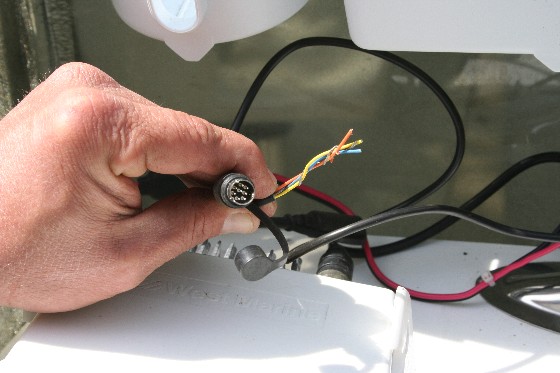Modern Marine Electronics: Networking Basics
Modern marine electronics are rarely stand-alone units. Here are some tips to help you get your network talking via NMEA 0183 or 2000.
April 15, 2012
Chartplotters, fishfinders, and other modern marine electronics have been more or less replaced by networking units known as MFDs (multi-function displays). The advantages of networked units range from space savings at the helm to lower initial cost to better usability, but sometimes networking your units is easier said than done.

Don't expect the color-coded wires to match up going from one manufacturer to another, especially with NMEA 0183 systems.
The most important feature to keep in mind is the “language” your unit speaks. If you match the brand of all of your units, this isn’t a big deal. Raymarine speaks to Raymarine, Simrad speaks to Simrad, and so on. But what happens when you have a Standard-Horizon VHF that needs to talk with a Furuno GPS? This is where NMEA 0183 and NMEA 2000 come in.
NMEA protocols allow units to play nice with each other using the same language. NMEA 0183 is a serial bus standard, which can deliver 4,800 bits per second. NMEA 2000 is a much faster 250K bits per second CAN (controlled area network) system akin to the one living in a modern automobile. When you set up your network you need to make sure all of your units are using one or the other, but not both (you can purchase “translators” that allow 0183 and 2000 units to communicate, but obviously this isn’t the preferred method).
When prodding units from different manufacturers to talk with each other, there are some common problems you’ll likely encounter. The worst is incorrect wire color-coding. On NMEA 0183 units, quite often one manufacturer will use blue while another will use green. NMEA 2000-compliant units are supposed to adhere to a standard (red/black for power/ground, bare for shield, blue/white for communications), but I’ve chopped open wires to find a surprise more than once when building a network. Worse, the owner’s manuals aren’t even reliable—I’ve held blue wires between my fingers while the manual insisted there were only greens, whites, and reds in existence. So when you go to get those units gabbing, don’t be shocked if you need to try a bit of wire-swapping to get it all figured out.
Another common problem arises when you have a unit that needs to be “told” to emit the NMEA data stream. Some do so at all times and others can auto-detect connections, but in many cases you’ll need to go into the unit’s menu and find a box to check or a sentence to highlight, which says “send NMEA data out,” or something along those lines. If you’re not aware of this issue, there could be a lot of head-scratching in your future.
The bottom line? If you’re upgrading an entire system, there’s no doubt that the easiest thing to do is toss out all of the old stuff and start fresh with a single manufacturer. But if mixing and matching is a must, you can rely on NMEA protocols to get those units talking—with a little effort on your part.
- Lenny Rudow












